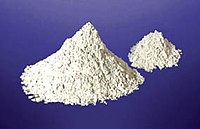
Photo from wikipedia
In this study, the tribological properties of the monolayer micro-crystalline diamond and nano-crystalline diamond films, TiN/diamond and TiAlN/diamond bilayer films on cemented tungsten carbide substrates are evaluated by dry sliding… Click to show full abstract
In this study, the tribological properties of the monolayer micro-crystalline diamond and nano-crystalline diamond films, TiN/diamond and TiAlN/diamond bilayer films on cemented tungsten carbide substrates are evaluated by dry sliding against the medium carbon steel counterpart balls, in terms of the coefficient of friction, wear rate, worn surfaces, and chemical transitions in the contacting wear zones. The significant coefficient of friction reducing effect of top-layer TiN and TiAlN coating only happens on the nano-crystalline diamond film, where the stable coefficient of friction of TiN/nano-crystalline diamond or TiAlN/nano-crystalline diamond bilayer coating reduces 9% or 53% compared with the nano-crystalline diamond film. The formed ionic metal oxides such as Fe2O3 or Fe3O4 coming from the chemisorbing of the atmospheric molecular water, oxygen in the air and the delamination of steel ball due to the repeated friction interaction is supposed to be responsible for the coefficient decreasing effect. The TiN or TiAlN film on diamond layer exhibits lower positive wear rate compared with the TiN or TiAlN film itself, due to the load support ability improvement resulted from the high hardness of diamond interlayers. Among all the tested hard films, the TiAlN/nano-crystalline diamond bilayer coating exhibits the valid potential to be the optimized tool coating in carbon steel machining in terms of its low coefficient of friction and wear rate, which may come from the self-lubricated transfer tribolayer formation on the TiAlN layer, as well as the enhanced mechanical supporting capacity of the underneath smooth and hard nano-crystalline diamond interlayer.
Journal Title: Proceedings of the Institution of Mechanical Engineers, Part J: Journal of Engineering Tribology
Year Published: 2018
Link to full text (if available)
Share on Social Media: Sign Up to like & get
recommendations!